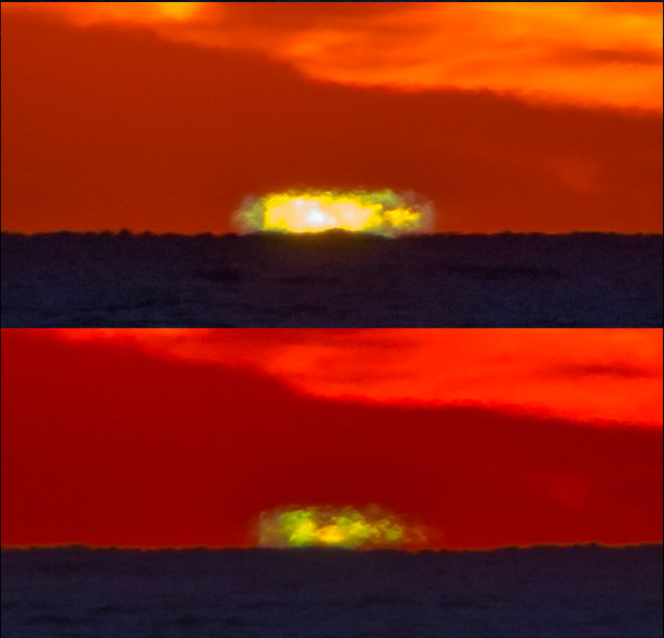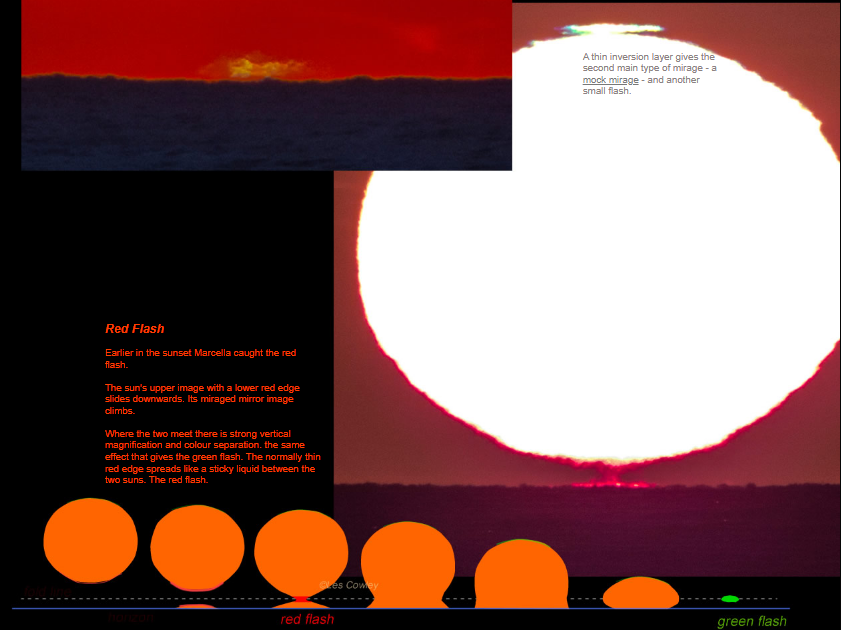Red & Green Flash, Sicily - OPOD
Red & Green Flash, Sicily - OPOD: Exploring the Phenomenon of Atmospheric Optics
Have you ever witnessed the captivating spectacle of a red or green flash during a sunset? These rare optical phenomena, known as the red and green flash, can be observed under specific atmospheric conditions. In this article, we delve into the intricacies of these mesmerizing events, focusing on the observations made by Marcella Giulia Pace at Marina di Ragusa in Sicily.
The Green Flash: A Mirage Above the Horizon
One of the most intriguing manifestations of atmospheric optics is the green flash. Marcella Giulia Pace captured a classical example of an inferior mirage green flash, poised just above the "horizon." However, it's important to note that the flash is not occurring at the actual horizon but rather at the ragged edge of a mirage. The mirage itself is formed due to turbulence, which flakes it into filmy fragments.
The green flash is a fleeting phenomenon, lasting only for an instant. It occurs when the final sliver of the setting sun is doubled and mirrored by the mirage. As one sliver descends, the other ascends, merging momentarily before vanishing. The mirage responsible for producing the green flash is formed when warmer air beneath the sea interacts with colder air layers. This temperature difference creates an optical illusion that amplifies the effects of atmospheric refraction.
Unraveling the Mystery of the Green Color
Curious about why the green flash appears green? As the sun approaches the horizon, it often develops an upper green rim. This green hue arises from normal atmospheric refraction, which elevates the sun's image. Shorter wavelengths, such as blue and green, experience greater refraction, resulting in a higher position for their corresponding sun disks. However, it's worth noting that this colored rim is only visible in large-scale images and cannot be observed visually, even if the sun is dimmed.
The mirage accompanying the green flash provides a glimpse into the true nature of these colors. At the point where the two slivers of the sun meet, there is a significant separation of colors, offering a highly magnified view of the sun's upper green edge. Below the sun, one can also observe a red edge, which will be further explored in the following section.
The Elusive Blue Flash and Rayleigh Scattering
While green flashes are relatively common near the horizon, blue flashes are much rarer. This scarcity can be attributed to the long path that rays of light must traverse through the air when near the horizon. As a result, Rayleigh scattering comes into play, depleting the blues and violets from the light spectrum. Although blue flashes do occur occasionally, they remain elusive compared to their green counterparts.
The Red Flash: A Magnified Vision of Sunset
Marcella Giulia Pace also managed to capture another fascinating phenomenon during sunset - the red flash. This occurrence takes place earlier in the sunset when the sun's upper image slides downwards, accompanied by a lower red edge that rises as its miraged mirror image climbs. When these two images converge, strong vertical magnification and color separation occur, similar to what is observed during a green flash. This effect causes the normally thin red edge to spread like a sticky liquid between the two suns, resulting in the striking red flash.
Witnessing these optical phenomena firsthand is undoubtedly a rare treat. However, it's important to exercise caution when observing them directly. Staring directly at the sun can cause severe damage to your eyes. Therefore, it is recommended to use proper solar viewing equipment or rely on photography to safely capture these remarkable moments.
In conclusion, the red and green flashes observed in Sicily offer a captivating glimpse into the world of atmospheric optics. Understanding the underlying mechanisms behind these phenomena enhances our appreciation for the beauty and complexity of the natural world. So, keep your eyes peeled during sunsets, and you might just catch a glimpse of these extraordinary displays of light and color.

Green.. ..& Red Flashes
Sunset images by Marcella Giulia Pace at Marina di Ragusa, Sicily.
A classical inferior mirage type green flash is caught poised just above the ‘horizon’. Not the real horizon but instead the ragged edge of a mirage. The mirage that produces the flash. Turbulence flakes the mirage to filmy fragments.
All images ©Marcella Giulia Pace, shown with permission

The flash, there for but an instant, is the final sliver of sun doubled and mirrored by the mirage.
One sliver descends, the other ascends. They merge and then are gone. Sea warmed air beneath colder stuff produces the mirage.
Why green? Near to the horizon the sun nearly always has an upper green rim. Normal atmospheric refraction raises the sun�s image. Shorter wavelengths refract most giving blue and green sun disks highest. The resulting coloured rim is only visible in large scale images � never look for it visually no matter how dimmed the sun.
The mirage reveals the colours. Where the two slivers meet there is strong colour separation showing us � highly magnified � the sun�s upper green edge. Beneath the sun there is a red one, see down the page.
Why not blue? Near the horizon rays have a long path through the air. Rayleigh scattering depletes the blues and violets. Blue flashes do occur but they are rare.


A thin inversion layer gives the second main type of mirage - a mock mirage - and another small flash
Red Flash
Earlier in the sunset Marcella caught the red flash.
The sun's upper image with a lower red edge slides downwards. Its miraged mirror image climbs.
Where the two meet there is strong vertical magnification and colour separation. the same effect that gives the green flash. The normally thin red edge spreads like a sticky liquid between the two suns. The red flash.
Note: this article has been automatically converted from the old site and may not appear as intended. You can find the original article here.
Reference Atmospheric Optics
If you use any of the definitions, information, or data presented on Atmospheric Optics, please copy the link or reference below to properly credit us as the reference source. Thank you!
-
<a href="https://atoptics.co.uk/blog/red-green-flash-sicily-opod/">Red & Green Flash, Sicily - OPOD</a>
-
"Red & Green Flash, Sicily - OPOD". Atmospheric Optics. Accessed on November 26, 2024. https://atoptics.co.uk/blog/red-green-flash-sicily-opod/.
-
"Red & Green Flash, Sicily - OPOD". Atmospheric Optics, https://atoptics.co.uk/blog/red-green-flash-sicily-opod/. Accessed 26 November, 2024
-
Red & Green Flash, Sicily - OPOD. Atmospheric Optics. Retrieved from https://atoptics.co.uk/blog/red-green-flash-sicily-opod/.